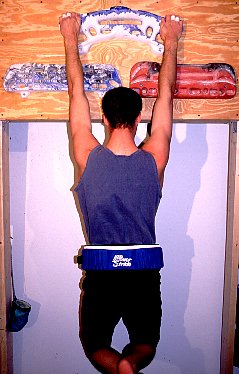How to Increase Your Strength 20% by Spring!
 Want to increase your "pull strength", lock-off ability, and lunging power a full 20 percent by Spring? Here's how. Commit to performing weighted pull-ups, three times per week, for the next ten weeks. Sound simple? Yes it is, but you need to make a commitment and follow through completely to obtain the results.
Want to increase your "pull strength", lock-off ability, and lunging power a full 20 percent by Spring? Here's how. Commit to performing weighted pull-ups, three times per week, for the next ten weeks. Sound simple? Yes it is, but you need to make a commitment and follow through completely to obtain the results.
First, give yourself a test. Determine how many complete, controlled pull-ups you can do on a pull-up bar or the bucket holds of a fingerboard. Write this number down, then calculate where you'd be with a 20 percent increase--this is your goal.
To achieve this goal we're going to leverage one of my hypergravity training techniques as detailed in my book, Training For Climbing. In a nutshell, we are going to simulate hypergravity (greater than gravity's natural pull) by adding weight to your body while you perform five sets of pull-ups. Ever notice how light your feet feel upon taking off a pair of ski boots or a heavy backpack? We are going to create the same effect with your climbing muscles! The key is to train with an additional 10 to 30 pounds (see note below) to trigger your neuromuscular system to adapt to this apparent increase in gravity. Long-term, you'll develop a new level of pull-up and lock-off strength--back on the rock at normal bodyweight, you just might begin to feel like you are climbing on the moon!
Here's the program. On your normal training and/or climbing days, perform five sets of weighted pull-ups, ideally toward the end of your session when the muscles are warmed up. For the first four weeks, use a 10-pound* weight belt (best) or a pack loaded with 10-pounds of gear. Do five maximal sets of pull-ups with at least a three-minute rest between set. Increase the weight to 20 pounds* for weeks five through eight, then to 30 pounds* for the final two weeks. Upon the completion of this ten-week program, take five days off from training, and then test yourself for the number of pull-ups you can do at bodyweight. I think you'll be pleasantly surprised!
As a final note, this hypergravity training is not appropriate if you are unable to do 10 consecutive pull-ups. Instead, commit to a similar three-day-per-week, ten-week program of pull-ups at bodyweight. The key to success is having a spotter aid you in doing 8 to 10 pull-ups in each of your five sets. Begin each set doing the pull-ups under your own power, but have the spotter grab hold at your hips and help lift you to complete the prescribed 8 to 10 reps. Within ten weeks, you should achieve 8 to 10 pull-ups on your own and feel way stronger on the rock!
*Note: If your bodyweight is less than 150 pounds (68kg), use half the weight prescribed above. Also, this program is not appropriate for climbers with recent history of elbow or shoulder injury.
PHOTO: Training with a 10-pound weight belt.



 Subscribe to Eric's RSS Feed
Subscribe to Eric's RSS Feed

3 Comments:
Eric
What do you think of single-set protocols?
This would involve a single set of pull-ups in any work-out session. Ideally keeping to the 8-15 rep level by using elastics or weights to alter the load.
The advantages I have found are: faster recovery, less muscle soreness and improved results in each session: often 1 extra rep in each subsequent session.
I also find that doing a single set takes less time (and motivation), and allows you to complete a greater variety of excerises.
The single-set protocal is used by some bodybuilders, but I do not view it as the best strategy for training for climbing. As a climber, you are after more than hypertrophy (which one heavy set may produce for bodybuilders); you also want to train local endurance of strength, and this will only come from doing several sets at a fairly high resistance. Yes, this multiple-set strategy will cause more soreness and require a longer recovery period, however, it is the optimal training strategy for climbers.
Thanks for your feedback. That is a good point! The studies I read based their results on an increase in maximum strength for a single repetition. Not optimal for endurance!
Post a Comment
<< Home